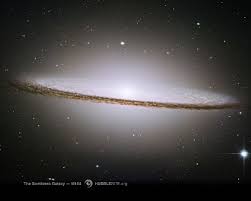
Over the past couple of weeks I've been working my way effortfully through a book which was often very difficult (to me at least) but at the same time poetically written and awe-inducing because of its subject matter - is the universe infinite or finite? and if the latter, how might we measure it? The book is
How the Universe Got its Spots by Janna Levin, an American astrophysicist or perhaps cosmologist. It's an unusual mixture of personal diary and an attempt to explain the mathematics and topology of the universe to a lay person - her mother, originally. I can't pretend to have understood more than fifty per cent of it, but Levin succeeds in explaining quite a few of the concepts that have eased into popular culture - and corrected a few of my popular misconceptions too. How about this, for example?:
"The big bang is not an explosion in space like a star exploding, where a ring of nebulous material surrounds an identifiable centre. Rather the big bang is the creation of space itself, of time. There is no sense to the question: how long was it before the big bang happened? Time started with the big bang. There is no sense to the question: where did the big bang happen? It happened everywhere. The earth
is at the centre in a sense. Every galaxy is at the centre. The centre is everywhere. The first sketch of our universe, its birth, life and death, begins here."
How can the universe be finite? It would be like one of those video games where one edge of the screen is the same as the opposite edge - if you travel in one distance long enough you get back to where you started. More amazingly, Levin suggests that we can measure the distance between these two identical locations in space by comparing the tiny differences that exist in background radiation and matching them up in both directions - mapping the patterns of "spots" to find those that are the same - they would in fact be the same places.
What does this have to do with SA? Not much - except that my flat here in Dunkeld turns out to be the centre of the universe, just like the place where you are now; and one of the pleasures of going to nature reserves in SA is that they're a long way from cities and so there's no light pollution - you can lay on the ground at night and stare up at an astonishingly bright Milky Way - which is the rest of our galazy, seen edge on, consisting of millions of stars; and is one of billions of
observable galaxies - the universe might be finite, but it's certainly very BIG. It tests my brain to consider such things even for a few minutes; I can't imagine a life dedicated to investigating the physics - and topology - and spots - of the universe.

 Over the past couple of weeks I've been working my way effortfully through a book which was often very difficult (to me at least) but at the same time poetically written and awe-inducing because of its subject matter - is the universe infinite or finite? and if the latter, how might we measure it? The book is How the Universe Got its Spots by Janna Levin, an American astrophysicist or perhaps cosmologist. It's an unusual mixture of personal diary and an attempt to explain the mathematics and topology of the universe to a lay person - her mother, originally. I can't pretend to have understood more than fifty per cent of it, but Levin succeeds in explaining quite a few of the concepts that have eased into popular culture - and corrected a few of my popular misconceptions too. How about this, for example?:
Over the past couple of weeks I've been working my way effortfully through a book which was often very difficult (to me at least) but at the same time poetically written and awe-inducing because of its subject matter - is the universe infinite or finite? and if the latter, how might we measure it? The book is How the Universe Got its Spots by Janna Levin, an American astrophysicist or perhaps cosmologist. It's an unusual mixture of personal diary and an attempt to explain the mathematics and topology of the universe to a lay person - her mother, originally. I can't pretend to have understood more than fifty per cent of it, but Levin succeeds in explaining quite a few of the concepts that have eased into popular culture - and corrected a few of my popular misconceptions too. How about this, for example?:






































